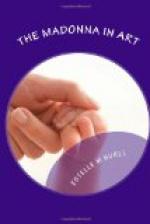One more picture remains for us to consider as an illustration of the Madonna as Witness. Had we mentioned it first, nothing further could have been said on the subject. The Sistine Madonna is the greatest ever produced, from every point of view. We have already noted the superiority of its artistic composition over all other enskied Madonnas, and are the more ready to appreciate its higher merits; for its strongest hold upon our admiration is in its moral and religious significance. Its theme is the transfiguration of loving and consecrated motherhood. Mother and child, united in love, move towards the glorious consummation of the heavenly kingdom.
[Illustration: RAPHAEL.—SISTINE MADONNA.]
It has been said that Raphael made no preparatory studies for this Madonna, but, in a larger sense, he spent his life in preparation for it. He had begun by imitating the mystic sweetness of Perugino’s types, drawn by an intuitive delicacy of perception to this spiritual idealism, while yet too inexperienced to express any originality. Then, by an inevitable reaction, he threw himself into the creation of a purely naturalistic Madonna, and carried the Mater Amabilis to its utmost perfection. Having mastered all the secrets of woman’s beauty, he returned once more to the higher realm of idealism to send forth his matured conception of the Madonna as the Christ-bearer.
The Sistine Madonna is above all words of praise; all extravagance of expression is silenced before her simplicity. Hers is the beauty of symmetrically developed womanhood; the perfect poise of her figure is not more marked than the perfect poise of her character. Not one false note, not one exaggerated emphasis, jars upon the harmony of body, soul, and spirit. Confident, but entirely unassuming; serious, but without sadness; joyous, but not to mirthfulness; eager, but without haste; she moves steadily forward with steps timed to the rhythmic music of the spheres. The child is no burden, but a part of her very being. The two are one in love, thought, and purpose. Sharing the secret of his sacred calling, the mother bears her son forth to meet his glorious destiny.
Art can pay no higher tribute to Mary, the Mother of Jesus, than to show her in this phase of her motherhood. We sympathize with her maternal tenderness, lavishing fond caresses upon her child. We go still deeper into her experience when we see her bowed in sweet humility before the cares and duties she is called upon to assume. But we are admitted to the most cherished aspirations of her soul, when we see her oblivious of self, carrying her child forth to the service of humanity. It is thus that she becomes one of his “witnesses unto the people;” it is thus that “all generations shall call her blessed.”
BIBLIOGRAPHY.
MRS. ANNA JAMESON: The Legends of the Madonna. Boston, 1896.
CROWE AND CAVALCASELLE: History of Painting in Italy. London, 1864. History of Painting in North Italy. London, 1871. Titian: His Life and Times. London, 1877.




